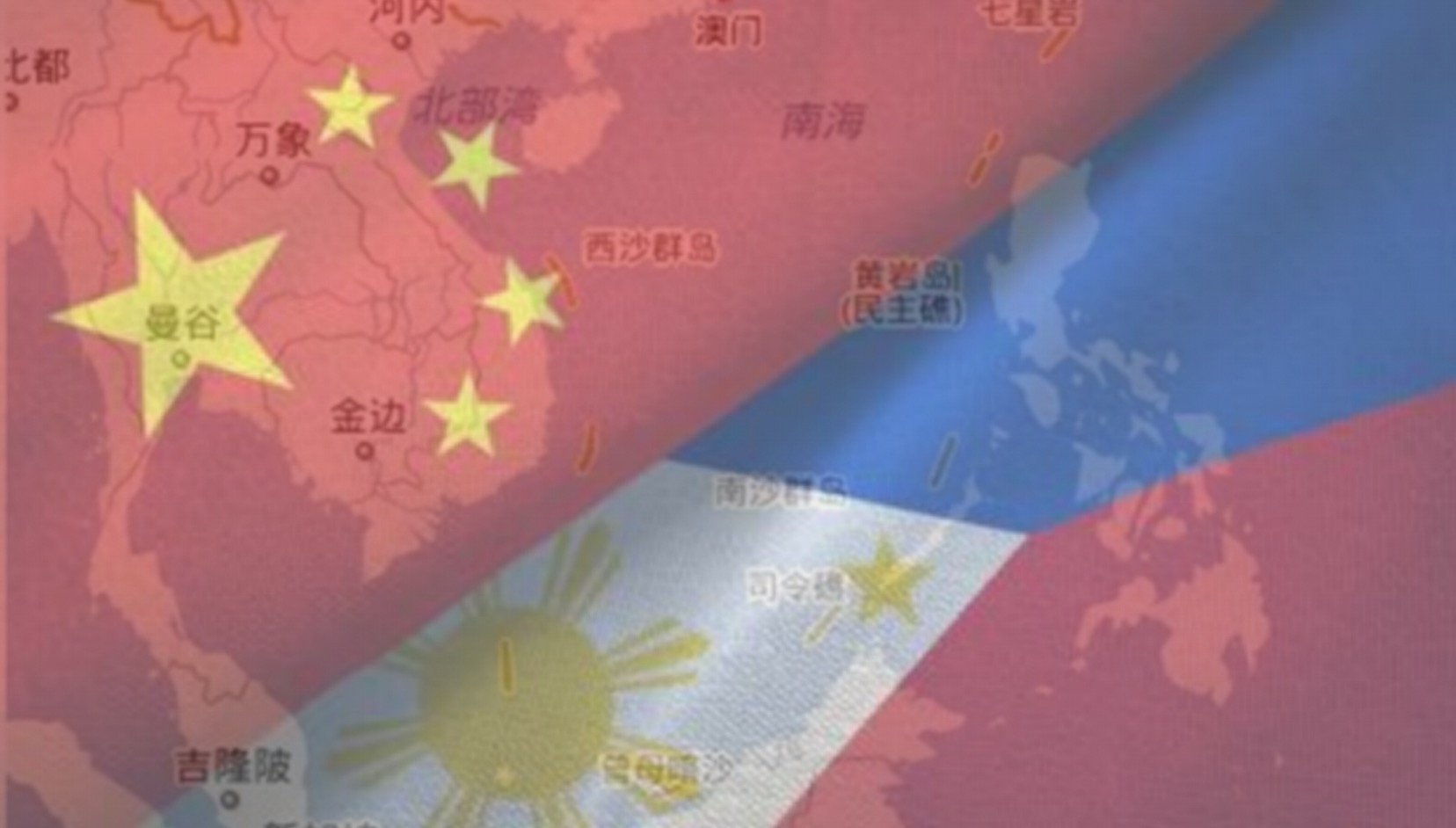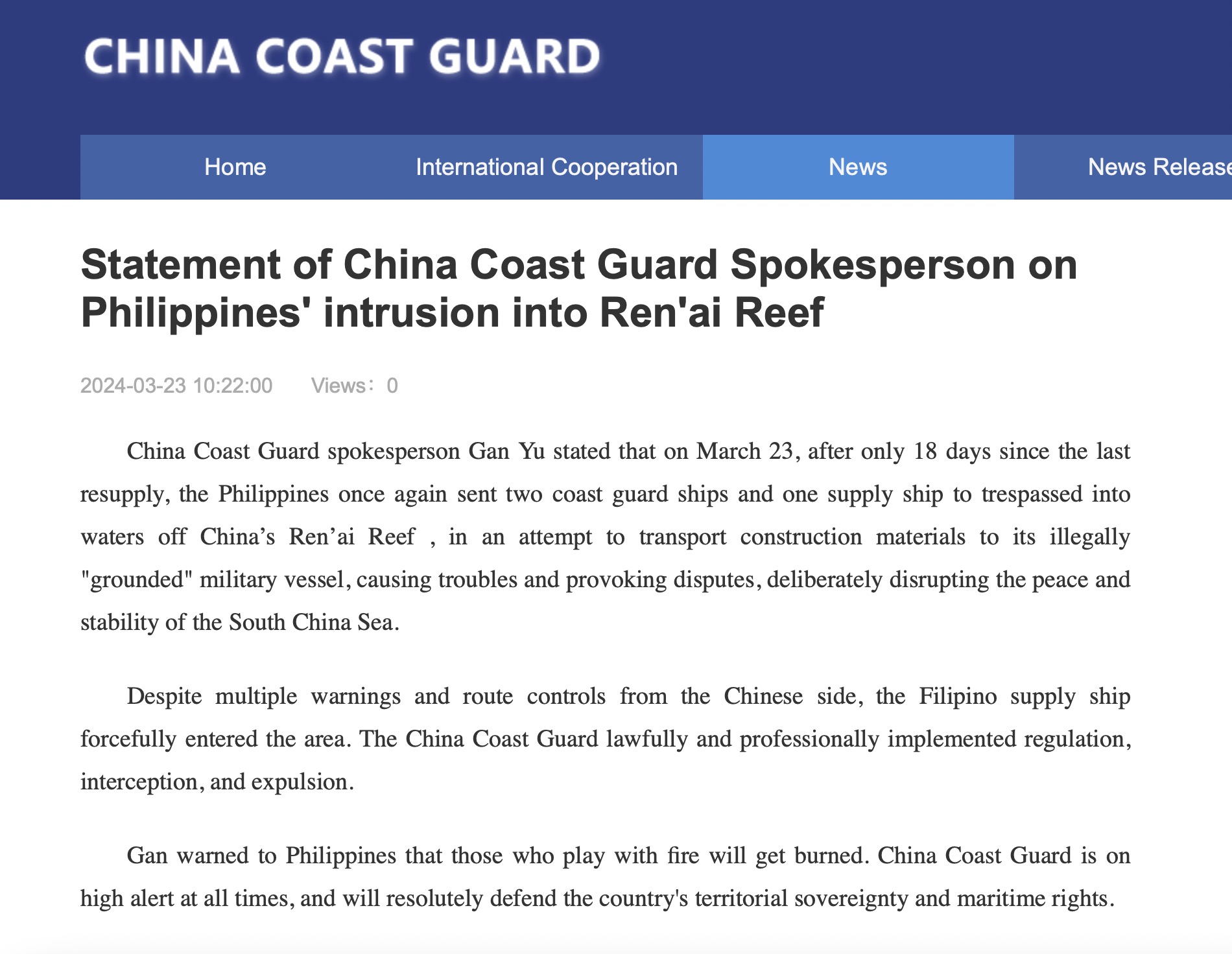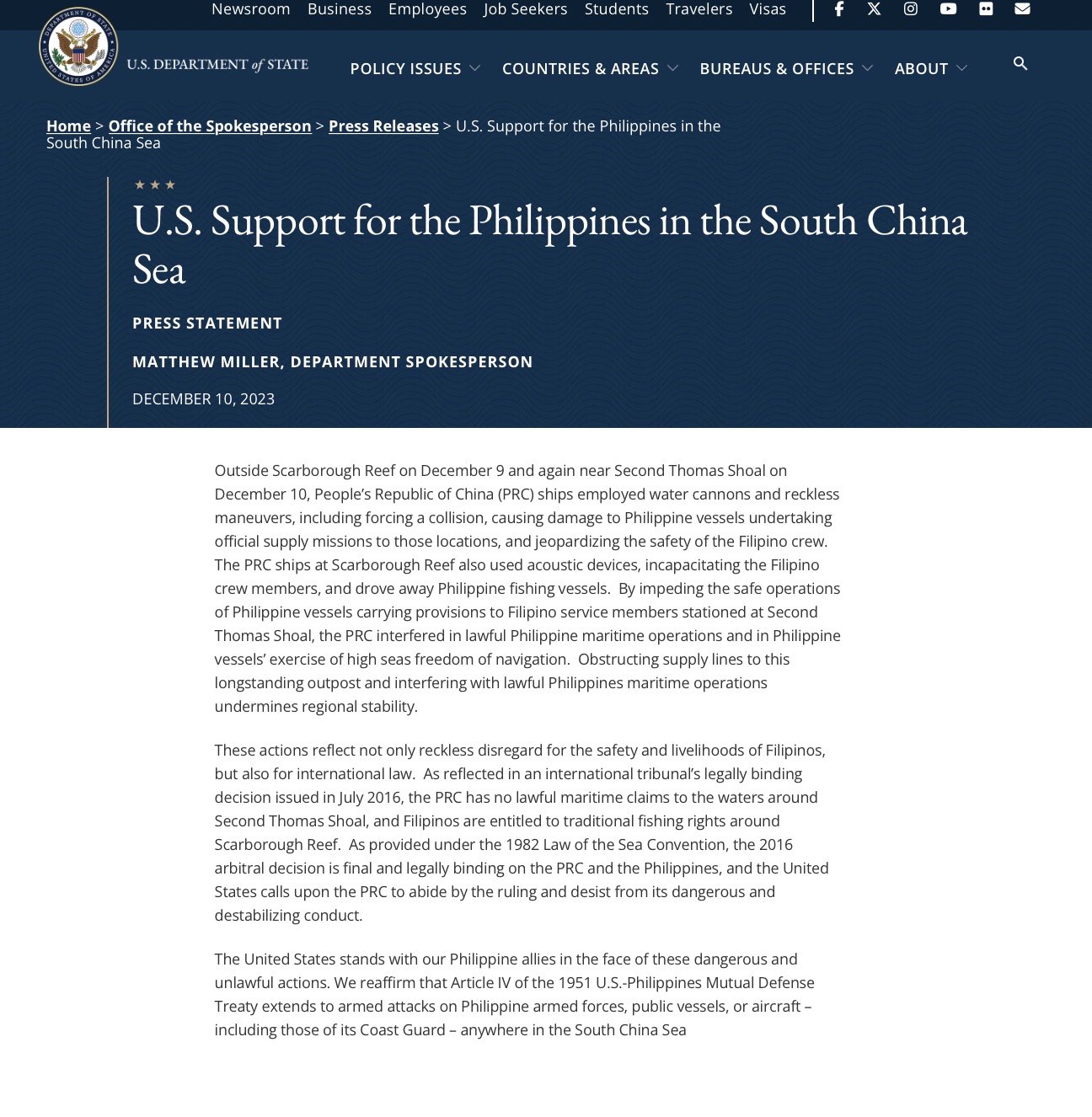Currently, much attention has been attracted by the tensions between China and the Philippines in the South China Sea. The recurrent provocative activities of the Philippines in the Scarborough Shoal (Huangyan Dao), Second Thomas Shoal (Ren’ai Jiao), and Sandy Cay (Tiexian Jiao) encountered a firm response from the CCG at sea. Some commentators are worried about the possibility of the escalation of the disputes, and blame China’s “dangerous action” in the Second Thomas Shoal against the UM4, a vessel controlled by the Philippines’ government to undertake the military rotation and resupply missions.
However, while commentators are all expressing their concerns for regional peace and stability, we cannot ignore the intentions behind the Philippines’ provocative activities as a whole and should be more cautious in assessing the potential implications of those activities. Let’s look at the three flashpoints: the three maritime features, Scarborough Shoal (Huangyan Dao), Second Thomas Shoal (Ren’ai Jiao), and Sandy Cay (Tiexian Jiao) are all uninhabited features that the Philippines attempts to occupy and take effective control of.

The Ambition of The Philippines to Expand Its Territorial Claims
In 1999, the Philippines’ warship BRP “Sierra Madre” was “grounded” on Ren’ai Jiao with the excuse of a mechanical fault. President Estrada promised to tow the vessel away as soon as it could be safely floated off the reef.[1] Thus, the Second Thomas Shoal is never considered an “inhabited feature”. Although now the Philippines turns to the South China Sea Arbitration Award to claim the feature is part of its EEZ and continental shelf, the territorial sovereignty dispute remains unresolved, because the Arbitral Tribunal cannot and did not touch upon China’s territorial claim to the Spratlys as a single unit.
However, the Philippines continuously delivered the construction materials to the Second Thomas Shoal and attempted to make it permanently occupied. On Aug 7, 2023, a Philippine Foreign Affairs spokesperson said the Philippines “decided to deploy a permanent station on Ayungin Shoal (the Philippines’ name for Ren’ai Jiao) in 1999”,[2] and several months later, spokesperson for the Armed Forces of the Philippines, Medel Aguilar, said that the Philippine government is considering building a permanent civilian structure.[3] From then on, the RoRe Mission became more and more intensified: the frequency went from 1 for every month to 1 for half a month. This year, the two States have reached a consensus on the living necessities supply to the personnel on the grounded warship. However, the Philippines breached its commitment by transporting construction materials on 23rd March, just 18 days after the previous RoRe Mission.[4]

Statement of China Coast Guard Spokesperson on Philippines' intrusion into Ren'ai Reef
This RoRe Mission to BRP “Sierra Madre” grounded at the Second Thomas Shoal cannot be read without what happened in Scarborough Shoal (Huangyan Dao) and Sandy Cay (Tiexian Jiao). Since last year, the Philippines has tried several times to control and occupy the Sandy Cay (Tiexian Jiao), a high-tide feature within 12nm of Subi Reef (Zhubi Jiao) in the Spratlys.[5] And on 21st Mar. 2024, 34 Philippine personnel illegally landed Sandy Cay (Tiexian Jiao).[6] The same thing happened in Scarborough Shoal (Huangyan Dao), on 28th Jan., 4 Philippine personnel illegally intruded the reef of Scarborough Shoal (Huangyan Dao) and were excluded by CCG.[7]
Therefore, in general, what the Philippines has done goes far beyond the so-called South China Sea Arbitration, the Philippines’ intention behind those provocative activities is to break the limits of the 3 international treaties that defined its territorial boundaries[8] to control more maritime features and waters in the South China Sea. This intention has also been revealed in its Senate version of “Maritime Zone Act”, reaffirming its territorial claim to the so-called “Kalayyan Island Group” high-tide features and Scarborough Shoal as well as providing that “[a]ll artificial island constructed within the Philippine EEZ shall belong to the Philippine government”.
Serious Breach of Paragraph 5 Of DOC
The Philippines’ activities in Second Thomas Shoal (Ren’ai Jiao), and Sandy Cay (Tiexian Jiao) have seriously violated Paragraph 5 of DOC, which requests the Parties to “exercise self-restraint”, including “refraining from action of inhabiting on the presently uninhabited islands, reefs, shoals, cays, and other features”. It is worth noting that, the term “uninhabited islands, reefs, shoals, cays and other features” clearly indicates that the Parties do not intend to identify the legal status of any maritime features, but to include all maritime features that are not inhabited at that time, i.e. the Second Thomas Shoal and Sandy Cay (Tiexian Jiao).
The 2002 DOC offered a platform for claimants of the South China Sea to manage their territorial and maritime disputes, and ensured the high-speed economic development of the region for 20 years. The DOC is a serious political commitment made by ASEAN members and China. Those commitments which have been repeated in the subsequent practice, reveal the common concerns of all Parties, and constitute the “greatest common divisor” of the interest of the Parties. For 20 years, the DOC has played an essential role in maintaining the stability and peace of the region, and the full implementation of the DOC is the basis of the COC consultation.
Paragraphs 4-6 are the substantial provisions of the DOC. It intends to create specific obligations for the Parties to manage disputes, promote practical cooperation, and resolve the dispute by peaceful means. The commitment to the non-occupation of uninhabited features reflects the common will of China and ASEAN members to manage the territorial dispute, and thus constitutes the regional mechanism for managing disputes. If the Philippines’ tricks are tolerant and ignored by others, the regional regime for managing territorial disputes would be derogated and undermined, which would probably open the “Pandora’s Box” for all claimants to enter into chaos of occupying uninhabited maritime features in the South China Sea.
The Possibility of The US Involvement
Commentators often examine the relationship between the US and the Philippines in the South China Sea from the US perspective, indicating that the US supports and encourages the Philippines to conduct more aggressively to pursue its priority in the competition against China. However, if we trace the path of the territorial claim expansion of the Philippines since the 1970s (under the administration of President Ferdinand Marcos), it may also suggest that President Marcos Jr. is taking the chance of the great power competition to accomplish its territorial expansion in the South China Sea.
Although the US reaffirms the “armed attack” on the Philippine armed forces, including PCG vessels would invoke US mutual defense commitment under Art. IV of the MDT, it is unlikely that the MDT would be applied in the South China Sea with such a low threshold at present. It is also interesting to note that the US emphasizes the armed attack “on the Philippine armed forces, public vessels, or aircraft” instead of “on the Island territories under its jurisdiction in the Pacific Ocean”, which means that the US does not want to get involved in the territorial disputes in the South China Sea.
The Statements of the US expressing its support for the Philippines can also demonstrate the US position.[9] Almost all of the US Statements are about the supply missions in the Second Thomas Shoal, which is considered a low-tide elevation by the US. The “Scarborough Shoal” is mentioned only once in its Statement of 10th Dec. 2023, regarding “the PRC ships at Scarborough Reef also used acoustic devices, incapacitating the Filipino crew members, and drove away Philippine fishing vessels”.[10] It seems that the US is prudent and cautious to keep the balance between protecting its ally and not taking a position on territorial disputes.

U.S. Support for the Philippines in the South China Sea, Dec. 10, 2023
But the US is almost on the edge of the Razor. By applying the “armed forces” clause, President Marcos Jr. may put the US into territorial disputes, or make others believe that the US would care about protecting the Philippines equivalent to its territorial claims beyond the boundary defined in international treaties. The Statement of 10th Dec. 2023 is a good example: even if there is a traditional fishing right for the Philippine fisherfolk, the fishing activities should be conducted under the jurisdiction of the owner of the Scarborough Shoal. The line between maritime interests and territorial claims is blurred, especially when the Philippines intends to benefit from the vagueness.
The Stability and Peace of The South China Sea
It is obvious that the peace and stability of the South China Sea largely rely on the successful management of the territorial disputes in the past decade. The self-restraint regime on not occupying uninhabited features works as the self-propelled engine, and the US’s position that not get involved in the territorial disputes also helps by leaving some room for the disputants to deal with their problems. However, both the internal and external engines may simultaneously break down because of the ambition of President Marcos Jr. None of the actors- China, the Philippines, other ASEAN members, as well as outside powers like the US- will benefit from it.
“A just cause gains great support, an unjust one gains little”. For more than 20 years, China and the ASEAN claimants have managed their disputes and maintained the stability and peace of this region. This success is rooted in the common interest of all States, regional countries and outside powers. It’s time for the Philippines to stop playing tricks, and back on the right track.

